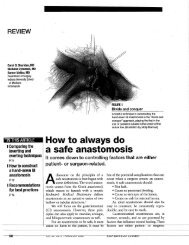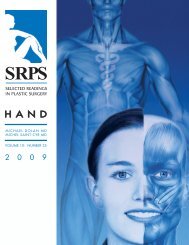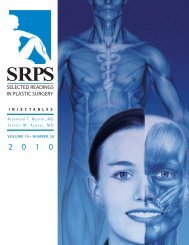Craniofacial Anomalies, Part 2 - Plastic Surgery Internal
Craniofacial Anomalies, Part 2 - Plastic Surgery Internal
Craniofacial Anomalies, Part 2 - Plastic Surgery Internal
Create successful ePaper yourself
Turn your PDF publications into a flip-book with our unique Google optimized e-Paper software.
SRPS Volume 10, Number 17, <strong>Part</strong> 2<br />
Fig 16. Posterior plagiocephaly from positional molding (above) and unilambdoid synostosis (below). Arrows indicate vectors of<br />
compensatory growth. (Reprinted with permission from Huang MHS, Mouradian WE, Cohen SR, Gruss JS: The differential diagnosis of<br />
abnormal head shapes: separating craniosynostosis from positional deformities and normal variants. Cleft Palate Craniofac J 35:204, 1998.)<br />
associated with a syndrome, and the remaining 20%<br />
were associated with multiple suture synostosis. 258<br />
Unicoronal synostosis causes regional growth<br />
restriction and compensatory expansion of the neighboring<br />
tissues, producing overt frontoorbital<br />
dysmorphology. Characteristic deformities ipsilateral<br />
to the synostosis include flattening of the frontal bone<br />
and ipsilateral forehead, ipsilateral elevation-recession<br />
of the supraorbital rim, and narrowing and lateral<br />
deviation of the orbit, deviation of the nasal root<br />
towards the flattened side, and elevation of the ipsilateral<br />
ear. 259 On the contralateral side there is bulging<br />
of the frontal bone. 260,261 An AP radiograph usually<br />
demonstrates the characteristic harlequin eye<br />
deformity. Bruneteau and Mulliken 262 believe that<br />
physical examination focusing on the supraorbital<br />
rims, nasal root, ears, and malar eminences can easily<br />
distinguish between synostotic and deformational<br />
plagiocephaly. This distinction has obvious clinical<br />
implications, as synostotic plagiocephaly is the only<br />
group with strong surgical implications.<br />
Lo and colleagues 263 described the endocranial configuration<br />
in unilateral coronal synostosis as follows:<br />
• constriction of the ipsilateral anterior cranial fossa<br />
• deviation of the anterior fossa midline<br />
• elevation of the ipsilateral floor<br />
• straightening of the lesser sphenoid wing<br />
These features of the cranial base correlate with<br />
the orbital dysmorphology. The authors reviewed<br />
28 patients with unicoronal synostosis and noted more<br />
21






